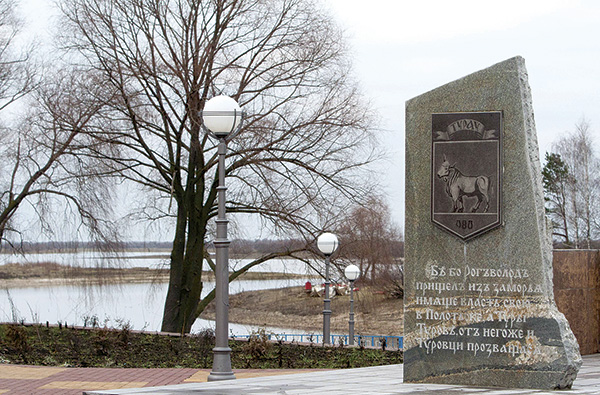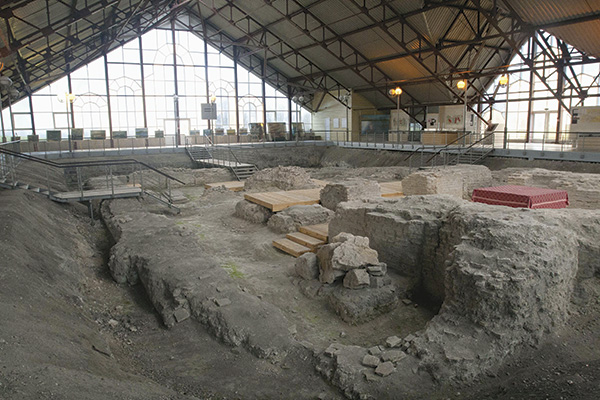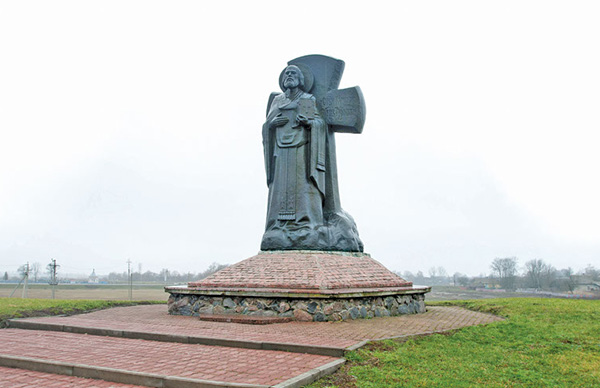Тurov and Polotsk have no equal among other Belarusian cities for their contribution to the history of Belarus. Polotsk, like Turov, boasts not only scientific achievements but unique historical buildings. In the 13th century, when Kievan Rus was experiencing its greatest civil strife, the city ceased to play an essential role and, in due course, became insignificant within the Grand Duchy of Lithuania.

The Polesie environment also promoted its oblivion, since the damp marsh air destroyed invaluable evidence of the former historical role of Turov. In the mid 1990s, I stayed in that town of just 4,000-5,000 people, in which the wooden homes had darkened. Badly organized streets led to the only square and, downstream of the high-water Pripyat, was a majestic man-made hill: an Orthodox cathedral once stood there.
You walk on history in the town, as I remember finding on coming across several dark-grey pieces of ceramic in a garden allotment. Apparently, there are 3m of soil in which artefacts may be hidden. Turov has begun to reveal its secrets, notes famous archaeologist Piotr Lysenko, a laureate of the State Award of Belarus, and Doctor of Historical Sciences. He stresses that Turov is equal in standing with ancient Polotsk, Kiev and Chernigov.

The foundations of the above-mentioned Orthodox cathedral are the largest find, at the top of the hill, on the bank of the Pripyat. Until recently, geese and cattle grazed there. The configuration of the building, so similar to the St. Sophia Cathedrals in Kiev and Polotsk, shows Turov’s connection with the ancient Slavic state. The cathedral was founded in the 1150s-1170s, by order of the outstanding Orthodox theologian and first Belarusian writer and bishop, Kirill Turovsky. His amazing eloquence can be compared with that of John Chrysostom. Historians are familiar with his 69 original sermons and other hand-written works, which provide evidence of oratorical talent, and his political weight.
Our contemporaries have believe the find has historical and public importance, as the former Chairman of Gomel Regional Executive Committee, Alexander Yakobson, asserted when the find first came to light. Piotr Lysenko appealed to him for support and was allocated the necessary finances to build a shelter for the foundations, made from glass and anodized aluminium. This protected it from the elements and allowed excavations to proceed efficiently. Within a few months, a museum had opened in the corner of the ruin. The Orthodox Church recognized the ancient cathedral and, since then, mass has been held annually, in memory of Kirill Turovsky.

Archaeologist Piotr Lysenko, a laureate of the State Award of Belarus, and Doctor of Historical Sciences
Thousands of believers regularly arrive to worship at the sacred place, looking from a platform down onto stone and brick almost ten centuries old. The place has a particular atmosphere, which relaxes some and makes others uneasy. Some even faint. In fact, an earthquake, which originated in the Carpathian Mountains, caused much destruction to the cathedral in 1230. Local residents pilfered the stonework to build their own homes, but several unique sarcophaguses made from slate remained and have been unearthed. Nothing similar has been found elsewhere in Belarus. Inside one was found the remains of a child: perhaps the young son of a prince.
Directly behind the church wall, a young woman’s remains have been uncovered. Her skull, being well preserved, allowed artist Leonid Yashenko to create a bust of her. Today, its plaster copy decorates Mr. Lysenko’s office, at the NAS of Belarus’ Institute of History. She looks attractive, and similar to young women today. According to the scientist, she may have been the favourite concubine of the prince.

“Ancient Turov” archeological complex. Diggings
It has been several decades since Piotr Lysenko purposefully investigated Turov District, discovering so much of interest. The Dregovichi tribe lived in the south of current day Belarus, and the principality of Turov was formed in the 10th century, when great Kievan Prince Vladimir Svyatoslavovich divided his grand principality between his sons. His third son, Sviatopolk, received Turov. At that time, Turov played an important role in Kievan Rus. In the 11th century, three of the six great Kievan princes were representatives of the Turov dynasty. Dynastic relations were complex, with Vladimir Monomakh carrying on intrigue in pursuit of the Turov throne, despite custom declaring that his son should reign. At the time, Turov principality stretched impressively from the Pripyat to modern Minsk, from the Dnieper River to lands beyond the Zapadny Bug (those belonging today to Poland).
Turov Principality, alongside Polotsk, was a powerful centre of Belarusian statehood. This sheds new light on the nature of Kievan Rus, showing its political, cultural, ethnic and territorial self-sufficiency.

“Ancient Turov” archeological complex. Slaty sarcophagus
Ancient Turov is only now restoring its historical greatness. At the modern level, of course. A monument to Kirill Turovsky, made by artist Mikhail Inkov, has been erected at the significant place of the city, based upon a depiction found on a lead plate, by Piotr Lysenko, during excavations. The Orthodox tradition continues via the majestic cathedral erected in the centre of Turov.
Local residents have preserved through the centuries their own dialect and gestures. These distinguish them from other Belarusians, as the Director of the Turov Centre for Creativity of Children and Youth, Yelena Poklonskaya, underlines. Born in Turov, she believes these features allow us a glimpse of how people would have spoken and behaved centuries ago, including princes. Proud yet sensitive, they differ from those living in nearby Polesie villages. While Turov residents preferred austere attire, in a single colour, their neighbours often chose brightly embroidered aprons, jackets and skirts. Turov even has its own dictionary, over several volumes.
Turov aspires to preserve its legacy, and plans to publish its dictionary of Turov dialect. The Turov Society, over which Piotr Lysenko presides, has published more than 20 literary miscellanies and books devoted to the history of his native land and its people. Pupils at the Children’s Creativity Centre sew amulet dolls and make clay figures, while studying the history of the ancient princely army.

The city has great hopes for the future too, with the local dairy plant building upon its global reputation for cheeses. A second stage of construction is planned, aiming to double production volumes. Meanwhile, tourism is developing, thanks to various historical sights. There is a strange stone cross, which appears to grow from the ground, and the floating hotel on the Pripyat River (the only one such in Belarus). You can fish from the deck!
Turov is now filled with modern homes and the centre is paved. A granite monument bears an inscription about Turov, with words quoted from the annals. The city aspires to find a worthy place in history, recalling its ancient power.
By Vladimir Bibikov
Interesting facts
Turov city is known as a motherland of ancient theologian and philosopher Kirill Turovsky (1130-1182), saints Martin and Lavrenty Turovsky also lived there. In the XIIth century 2 monasteries and 85 churches operated in Turov Principality











